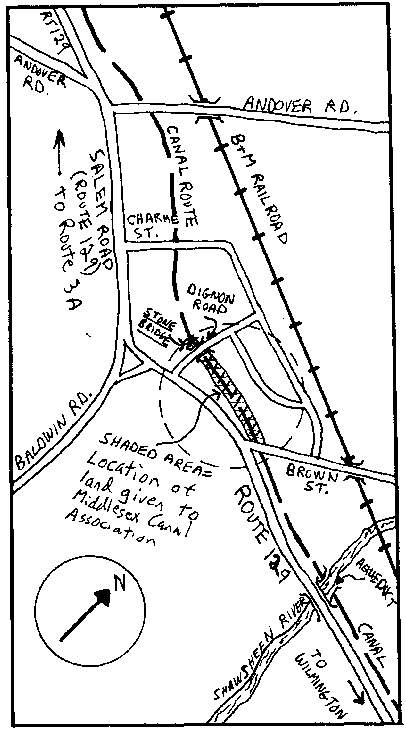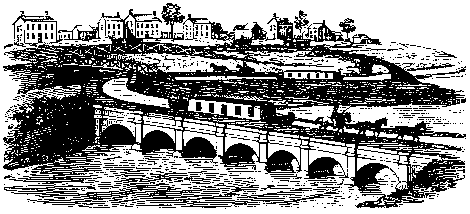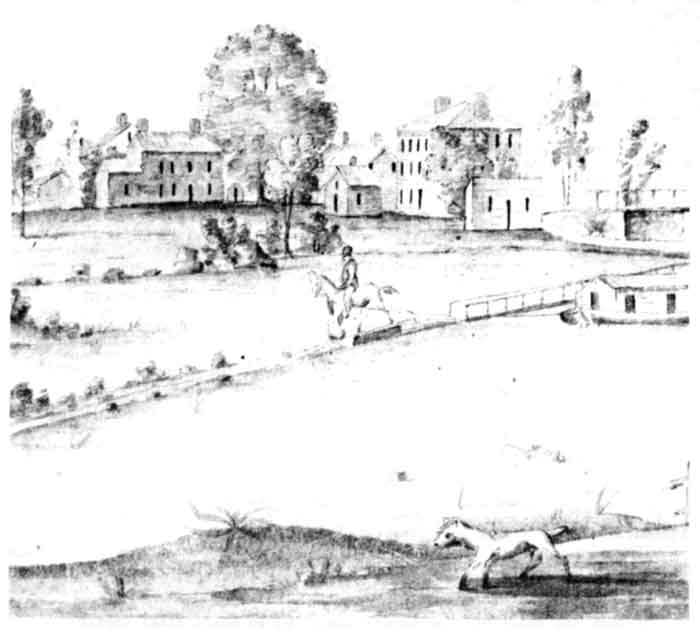


Middlesex Canal Association P.O. Box
333 Billerica, Massachusetts 01821
VOL. 20, NO. 1 OCTOBER, 1981
20TH ANNUAL MIDDLESEX CANAL WALK
Saturday, October 24. Billerica.
Meet at Hajjar School, junction of Call and Rogers Streets, at 1:30pm. From Billerica Center, proceed north on Route 3A to 1st traffic light, 1 mile; bear right on Pollard Street (avoid Route 129) for ½ mile. Go right on High Street, cross railroad tracks, turn left on Rogers Street, school will be on left. A 4 mile woodland walk partly along canal remains. Potluck supper $2.00 served by Boy Scout Mothers. Register by October 22 with Edith Choate, 429 West Street, Reading (617-944-0129). Troop 55 BSA will serve as guides, and Middlesex Canal Association will provide lecturer, Louis Eno. Leaders: Malcolm C. Choate, AMC; Louis Eno, MCA; and Harold Westaway, BSA.
CANAL CLEAN UP
The Middlesex Canal Association will have a canal clean up at our newly acquired land in Billerica. This site was generously donated to the Association by Mr. Frank Dignon.
We will need PLENTY of "Hands" on Saturday, November 28th, from 1 to 4pm.
Refreshments and clean-up equipment will be provided.
The site is located at the stone bridge on Dignon Road, off Route 129 (north of the Shawsheen Aqueduct), Billerica. For further directions, see the map or call Gina Henchey at 389-1926.
PRESIDENT'S MESSAGE
|
With the falling of the autumn leaves, the Middlesex Canal Association continues with a very active fall season. I enjoyed seeing many of our members and friends at the Baldwin Society's Apple Festival in Woburn last month and at the start of our recent trip to the Delaware & Hudson Canal in New York. I hope to see even more of you and your friends on October 24th at the 20th Annual Canal Walk in Billerica. Malcolm Choate, our regular leader, will sit this one out to recover from a recent illness (Malcolm sends along his thanks to those who sent cards!). In any event, Louis Eno will provide expert commentary on this interesting section of the canal. I am pleased to announce that the Board of Directors has completed the transfer of title to the Association of our first actual section of the Middlesex Canal. With deepest appreciation, we acknowledge this generous gift from Mr. Frank Dignon of Billerica of the portion of the canal route from Brown Street to slightly beyond Dignon Road in Billerica. This is the first clearly visible section of the canal ditch north of the Shawsheen Aqueduct. We'll be having a clean-up day in November (see separate article and map) to get the land in shape for a spring dedication. Again, our sincere thanks to Mr. Dignon for his kind gift. I also want to thank Nolan Jones and Gina Henchey for their ambitious efforts to set up our fall trip to New York. With the valuable assistance of Paul Ross of the D & H Canal Society, the weekend featured tours of the visible remains of the Delaware & Hudson Canal between Eddyville and High Falls, along with a visit to the D & H Canal Society's museum at High Falls. On Sunday, participants enjoyed lunch at the Beekman Arms Hotel in Rhinebeck, New York, known as the oldest inn in America. This was followed by a visit to the old Rhinebeck Aerodrome and its "Aerial Stage Show", featuring World War I aircraft. We hope that this is only the beginning of a regular series of trips to other canals and historical sites. The fall season is an excellent time to visit our Middlesex Canal exhibit at the Museum of Transportation in Boston. For those who missed the Annual Meeting or who were too busy talking with other MCA friends (like I was!) to really examine the exhibit, a trip to Museum Wharf will be well worth the effort. The museum is open daily from 10am to 5pm. Of course with the falling leaves, you will soon find your dues renewal notice in the mail. Contrary to what most organizations are doing, we are keeping the membership dues at the same level as last year. Therefore, we urge you to send in your payment quickly to save membership chairman, Burt VerPlanck, and the Association the time and expense of a second dues notice. As always, I and the other members of the Board of Directors are anxious to hear your ideas on how we can best serve our members. I am looking forward to seeing you on October 24th in Billerica. Larry Henchey |
 |

As many canalers are no doubt already aware, the Middlesex Canal Packet, "Colonel Baldwin", which for the past several summers has carried passengers along the old canal in North Woburn near the Baldwin Mansion; did not operate this summer season.
The Woburn Historical Commission, which owns the packet, and the Woburn Canal Society, who operate the excursions are busily conducting the first vessel maintenance in nearly five years. Thus the craft has been "drydocked" for this season only.
The Historical Commission will be repainting the boat soon, and urgently requests MCA members submit suggested color schemes for the hull and cabin. Send your scheme, indicated on the sketch and send it to us at 33 Elm Street, North Woburn. Remember in your deliberations that the old canal boats were painted as "gaudey as circus wagons" -- so don't be afraid that your colors won't be suitable.

|
A membership in the Middlesex Canal Association makes a fine (and unusual) Christmas gift. |
|
||||
THE TOOTHAKER (?) TAVERN (?)
By Jane B. Drury

Is the beautiful Federal style, brick-ended house located on Rogers Street in North Billerica where the Middlesex Canal starts south from the Concord River mill pond really an old Toothaker tavern? This question is often discussed when the association passes the house on its annual fall walk along the canal. The answer? No, this dwelling never was owned by the Toothaker family, and probably never was a tavern, but . . . .
Billerica's first Roger Toothaker arrived in America in the ship "Hopewell" in 1635. In 1660 the town of Billerica granted him "lyberty to live in ye Towne, and to settle upon and Improve yt lot . . . which lyeth in the great comon feild on ye East side of Concord River, below ye great bridge," This land probably included the site of the present brick-ended house.
Although local records do not call him doctor, Roger Toothaker was known by that title in Salem. Apparently he spent a lot of time practicing medicine in that town, away from his family. In 1682-3 the Billerica selectmen recorded, "Roger Toothaker, being sent for and spoken unto concerning many things amiss in his family, he desired they would exercise a little more patience towards him." Patience seems to have run out by 1684, however, when the selectmen wrote him a letter requesting that he "come for his wife ye midle of next week, and that they would help away with his family -- in case of need and help fit them out." Involved in Salem with medicine and as a witness in witchcraft trials, he did not heed this request, and his wife, Mary, was given charitable aid by the town and two of his children were indentured out by the selectmen. Even the continued danger of Indian attacks did not bring him to the aid of his family. During the day of August 5, 1695, the year after the death of Roger Toothaker, Indians entered Billerica un-noticed and on horseback. Fifteen persons, including Roger's widow, Mary, were killed in the raid, and her youngest daughter, Margaret, was taken captive.
The next three generations of men to live in this house were also named Roger Toothaker, and they were all physicians. No evidence has been found to indicate they were also innholders. In 1782 "Roger Toothaker, yeoman," deeded the old house and thirty acres of land to "William Rogers, husbandman."
This land lay in the path of the proposed canal, and in August 1794 "William Rogers, Gentleman," sold to the Proprietors of the Canal seven acres of his farm. In October of that year he and his wife, Hannah, started boarding Prince Cummings, a laborer helping to build the canal. From then through 1823 William Rogers would occasionally board one or two workers in the house for varying periods, for which he was paid by the Proprietors. However, the Rogers house was only one of several private homes in which men stayed while working on the canal. Boarding houses owned by the Proprietors were also used during construction of the canal and later for men maintaining the canal. Much food and rum were delivered to the boarding houses and charged to the Proprietors.
By 1807 eight of William and Hannah's children had been born, and the old Toothaker dwelling, now about 140 years old, was becoming too small. At that time William built the present lovely brick-ended house, retaining the old building as an ell attached to the rear of the new. In 1916 Miss Harriet B. Rogers, granddaughter of William and Hannah, wrote, "There was then (1807) only one other house as fine . . . The ornamental woodwork at the top of the wainscotting and at the ceiling together with the flower painted walls, probably gave it its distinction." A lovely fanlight over the main doorway decorated the facade.
The road which passes in front of the house then crossed the Middlesex Canal over "Rogers Bridge, No. 42." In 1819 this bridge fell down and had to be rebuilt.
Through the years William Rogers continued to board canal workers and provide teams and various supplies. He was paid by the Proprietors for shoeing horses and oxen, mending plow irons and bridle bits, drawing rocks, building fences, and supplying items such as nails, spikes, paper supplies, and rum. During a period at least as early as 1818 and as late as 1825 he was the toll collector at Landing No. 3 in Medford.
In 1834 William and his son Calvin sold to the Boston and Lowell Railroad Corporation a strip of their farm 2760 feet long and 4 rods wide. This became the location of the present Boston and Maine Railroad tracks which parallel the canal. The corporation agreed to build a cattle culvert with proper drainage "so the same may be kept dry, " and it further covenanted to pay the Rogers $200 if they should ever be deprived of the right to cross the railroad.
Following the death of William Rogers in August 1838, his son Calvin resided in the house with his family and widowed mother. Only one bill paid by the Proprietors to Calvin remains in the Canal records, and that was for hay, dated 1834, before his father died, and eleven years after the last workers were boarded in the house. Three of Calvin's five daughters are of interest historically. Mary Howe, born in 1827, married Thomas Talbot, a very respected man who became Lieutenant Governor and Governor of the State, as well as President of the Boston & Lowell Railroad. Elvira, born in 1830, married in 1866 Joseph Gould, who was in charge of the Talbot Dyewood & Chemical Co. The remains of the foundations of the chemical works can still be seen between the canal and the railroad tracks. Harriet Burbank, born in 1834, was the principal of the School for the Deaf, which was established in Chelmsford in 1866 and was the first organized school in the country to teach the deaf strictly by the oral method. This school is now the Clarke School for the Deaf in Northampton.
An old well, used by the Toothaker and/or Rogers families, was located across the road from the house in a pine grove that formerly stood by the river. A young boy named Michael Thomas Harrigan is said to have drowned in this well when he was under five years of age. Michael had been born in 1844, the oldest son of Bartholomew and Joanna Harrigan. Bartholomew was a weaver and also probably the last tender of the canal lock which was situated a little east of the house. The Harrigans lived next door to the Rogers family.
Soon after the death of his mother, the widow Hannah, in 1856, Calvin Rogers sold the homestead to James R. and Charles Faulkner, brothers of his wife, and moved to his new home on Mt. Pleasant Street. It was during this next ownership that the old ell, probably the Roger Toothaker house, was finally torn down. It was still standing in 1889, but by 1911 it had been removed and two new ells added at the rear of the house, which the Faulkner Manufacturing Co. converted to a two-family tenement. In 1916 the company sold the house to the family currently residing there.
Sources:
Illustration: Detail from William Barton painting of North Billerica millpond (1825). Courtesy of Billerica Historical Society.
The author wishes to express her deep appreciation to the Billerica Historical Commission and to the Billerica Historical Society for their assistance in the preparation of this paper.